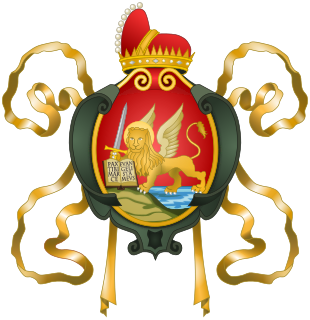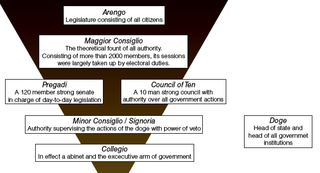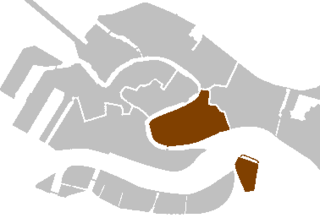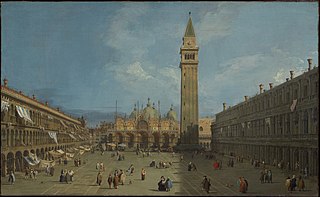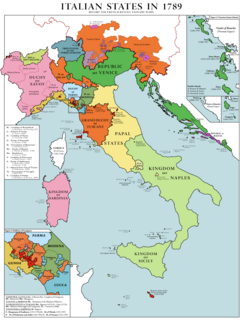
Francesco Foscari was the 65th Doge of the Republic of Venice from 1423 to 1457. His reign, the longest of all Doges in Venetian history, lasted 34 years, 6 months and 8 days, and coincided with the inception of the Italian Renaissance.

Jacopo d'Antonio Sansovino was an Italian sculptor and architect, known best for his works around the Piazza San Marco in Venice. Andrea Palladio, in the Preface to his Quattro Libri was of the opinion that Sansovino's Biblioteca Marciana was the best building erected since Antiquity. Giorgio Vasari uniquely printed his Vita of Sansovino separately.

The Basilica di Santa Maria Gloriosa dei Frari, usually just called the Frari, is a church located in the Campo dei Frari at the heart of the San Polo district of Venice, Italy. One of the most prominent churches in the city, it has the status of a minor basilica. The church is dedicated to the Assumption of Mary.
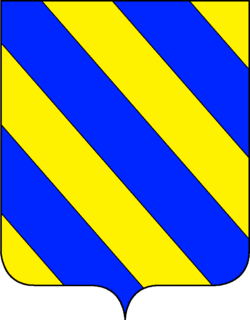
Contarini is one of the founding families of Venice and one of the oldest families of the Italian Nobility. In total eight Doges to the Republic of Venice emerged from this family, as well as 44 Procurators of San Marco, numerous ambassadors, diplomats and other notables. Among the ruling families of the republic, they held the most seats in the Great Council of Venice from the period before the Serrata del Maggior Consiglio when Councillors were elected annually to the end of the republic in 1797. The Contarini claimed to be of Roman origin through their patrilineal descendance of the Aurelii Cottae, a branch of the Roman family Aurelia, and traditionally trace their lineage back to Gaius Aurelius Cotta, consul of the Roman Republic in 252 BC and 248 BC.

Marco Barbarigo was the 73rd Doge of Venice from 1485 until 1486. His nomination took place on a new staircase in the courtyard of the Doge's Palace, on an axis with the Campanile of St. Mark and the Porta della Carta.

The Biblioteca Nazionale Marciana is a public library in Venice, Italy. Founded in 1468 as the library of the Republic of Venice, it is one of the earliest surviving public libraries and depositories for manuscript in Italy and holds one of the greatest collections of classical texts in the world. It is named after St. Mark, the patron saint of the city.
Giustiniano Participazio was the eleventh (traditional) or ninth (historical) Doge of Venice from 825 to his death. His four years on the ducal throne were very eventful. He was made hypatus by the Byzantine emperor Leo V the Armenian.

The Museo Correr is a museum in Venice, northern Italy. Located in St. Mark's Square, Venice, it is one of the 11 civic museums run by the Fondazione Musei Civici di Venezia. The museum extends along the southside of the square on the upper floors of the Procuratorie Nuove. With its rich and varied collections, the Museo Correr covers both the art and history of Venice.
San Marco, the Italian form of Saint Mark, is one of the six sestieri of Venice. It may also refer to:

Ludovico Giovanni Manin was a Venetian politician, a Patrician of Venice and the last Doge of Venice. He governed the Venetian Republic from 9 March 1789 until 1797, when he was forced to abdicate by Napoleon Bonaparte.

The Venier were a prominent family in the Republic of Venice who entered the Venetian nobility in the 14th century. Their members include:

The Lion of Saint Mark, representing the evangelist St Mark, pictured in the form of a winged lion holding a Bible, is the symbol of the city of Venice and formerly of the Venetian Republic.

Antonio Cappello (1494-1565) was a Venetian noble, a member of the San Polo branch of the Cappello family. A Procurator of St Mark's, he acted as ambassador to the court of Charles V at Gand, but is mainly remembered for his role as one of the main promoters of public art and architectural projects in sixteenth-century Venice. He resided in the palazzo on San Polo now known as Ca Cappello Layard and oversaw its redevelopment.
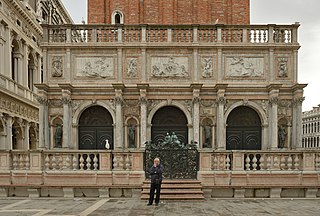
The Loggetta is a small, richly decorated building at the base of the bell tower in Saint Mark’s Square, Venice, Italy. Built by Jacopo Sansovino between 1538 and 1546, it served at various times as a gathering place for nobles and for meetings of the Procuratori di san Marco, the Venetian officials responsible principally for the administration of the treasury of Saint Mark’s Basilica and for the public buildings around Saint Mark’s Square.




